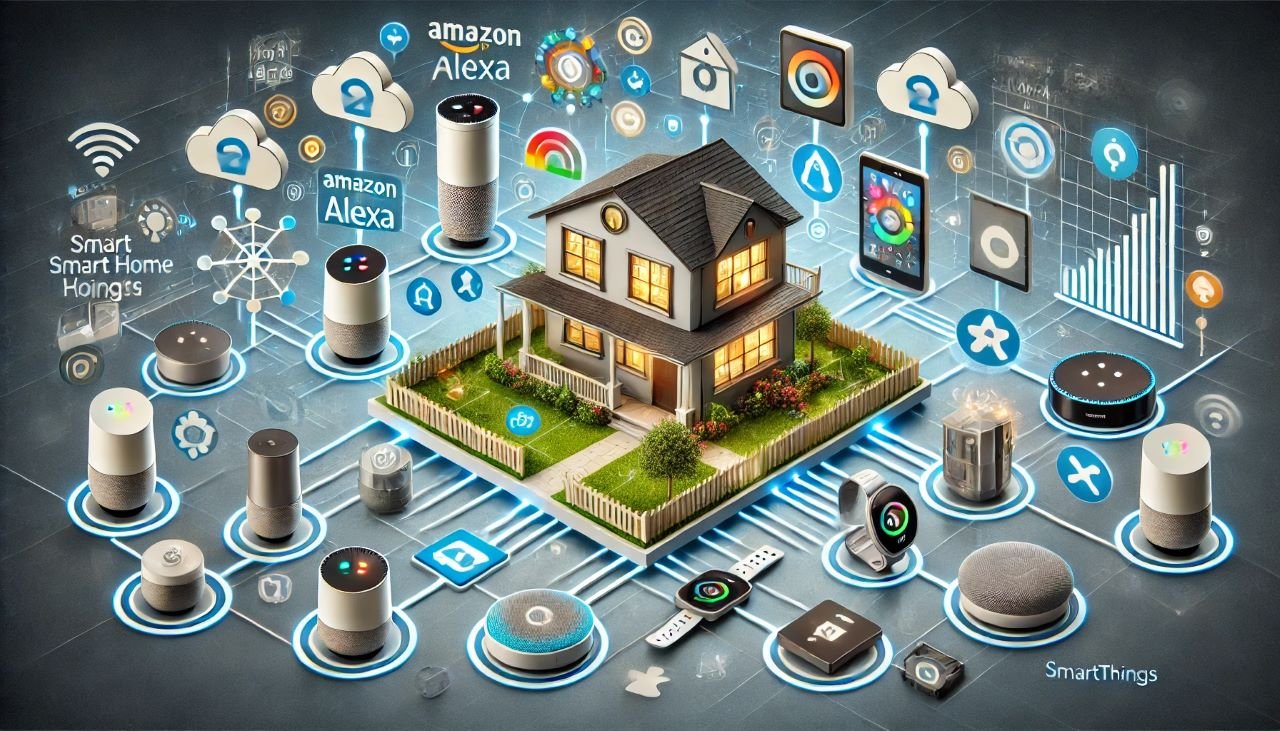Interoperability and Integration in Smart Home Platforms
1. Overview
Interoperability and integration are crucial aspects of smart home technology, determining how well various devices and systems work together within a smart home ecosystem.
A seamless integration experience enhances the user experience, allowing for easy control, automation, and management of all smart home devices, regardless of brand or type.
This report delves into the concepts of ecosystem compatibility, third-party integrations, and the importance of interoperability in smart home platforms.
2. Understanding Ecosystem Compatibility
2.1 Definition and Importance:
Ecosystem compatibility refers to the ability of different smart home devices to work together within a unified platform or system.
In a compatible ecosystem, devices communicate effectively, share data, and function cohesively under a single control interface, such as a smartphone app or voice assistant.
Compatibility is vital for a smooth user experience, as it ensures that users can control all their smart devices from one platform without the need for multiple apps or interfaces.
A highly compatible ecosystem also allows for more complex automation routines and scenarios, where multiple devices interact with each other based on user-defined triggers and actions.
2.2 Types of Ecosystems:
Closed Ecosystems:
Some smart home platforms, like Apple HomeKit, operate within a more closed ecosystem, where only devices that meet specific criteria or certifications (e.g., HomeKit certification) can be integrated.
This approach often ensures a high level of security and reliability but limits the range of compatible devices.
Open Ecosystems:
Platforms like Amazon Alexa and Google Home are more open, supporting a wide range of devices from various manufacturers.
This flexibility allows users to mix and match devices according to their preferences and needs, but it can also lead to challenges in ensuring smooth interoperability.
2.3 Key Considerations for Ecosystem Compatibility:
Device Certification:
Devices that are certified by the platform (e.g., “Works with Alexa,” “Works with Google Assistant”) are more likely to offer seamless integration and compatibility.
Communication Protocols:
The underlying communication protocols (Wi-Fi, Zigbee, Z-Wave, Bluetooth, etc.) play a significant role in determining compatibility.
Devices using the same protocol are generally more compatible within a platform.
User Interface Consistency:
A compatible ecosystem should offer a consistent user experience across all devices, with unified control through a single app or interface.
Reliability and Security:
The integration should not compromise the reliability or security of the system, particularly when dealing with critical devices like security cameras or smart locks.
3. Third-Party Integrations
3.1 Definition and Significance:
Third-party integrations refer to the ability of a smart home platform to support devices and services from manufacturers and developers outside of the platform’s original ecosystem.
This openness is crucial for expanding the functionality of a smart home system, allowing users to incorporate a wider variety of devices and services into their setup.
3.2 Examples of Third-Party Integrations:
Smart Lighting:
Philips Hue is a popular smart lighting system that integrates with multiple platforms, including Amazon Alexa, Google Home, Apple HomeKit, and Samsung SmartThings.
Security Systems:
Ring, a well-known smart doorbell and security camera system, offers integrations with various platforms, allowing users to control and monitor their security devices through their preferred smart home platform.
Streaming Services:
Platforms like Alexa and Google Home integrate with streaming services such as Spotify, Netflix, and YouTube, enabling voice-controlled media playback and multi-room audio configurations.
Voice Assistants:
Many smart home devices integrate with multiple voice assistants, providing users with flexibility in how they control their devices.
For instance, a smart thermostat may work with Alexa, Google Assistant, and Siri.
3.3 Benefits of Third-Party Integrations:
Expanded Functionality:
Third-party integrations allow users to access a broader range of devices and services, enhancing the capabilities of their smart home system.
User Flexibility:
Users are not locked into a single brand or ecosystem, giving them the freedom to choose devices that best meet their needs and preferences.
Innovation and Development:
Open platforms that encourage third-party integrations often see faster innovation and more diverse product offerings, as manufacturers and developers create new devices and services to meet market demand.
3.4 Challenges of Third-Party Integrations:
Compatibility Issues:
Not all third-party devices integrate seamlessly with all platforms.
Users may experience glitches or limitations in functionality, especially if the devices are not certified by the platform.
Security Risks:
Third-party integrations can introduce security vulnerabilities if the devices or services do not adhere to the same security standards as the primary platform.
Complexity in Setup:
Integrating third-party devices may require additional setup steps, including the use of multiple apps or services, which can complicate the user experience.
4. Importance of Interoperability in Smart Home Platforms
4.1 Definition:
Interoperability in smart home platforms refers to the ability of different devices, systems, and services to work together smoothly, regardless of the manufacturer or platform.
High interoperability ensures that users can control and automate all aspects of their smart home from a single interface, without compatibility issues or the need for multiple control systems.
4.2 Key Components of Interoperability:
Standardized Communication Protocols:
Using common communication protocols (e.g., Zigbee, Z-Wave) enhances the ability of devices from different manufacturers to work together.
Cross-Platform Support:
Devices that support multiple platforms (e.g., working with both Alexa and Google Home) are more interoperable, offering users greater flexibility.
Unified Control Interfaces:
Platforms that offer a single app or voice assistant to control all connected devices contribute to better interoperability, simplifying the user experience.
API and SDK Availability:
The availability of application programming interfaces (APIs) and software development kits (SDKs) allows third-party developers to create integrations that enhance interoperability.
4.3 Examples of Interoperability in Action:
Voice Control Across Platforms:
A user can control their smart thermostat using either Alexa or Google Assistant, thanks to the device’s support for both platforms.
Multi-Device Automation:
A smart home system can trigger a series of actions across different devices (e.g., turning off lights, locking doors, adjusting the thermostat) with a single command, even if the devices are from different manufacturers.
Cross-Platform Streaming:
Users can stream music from a service like Spotify across multiple smart speakers from different brands, thanks to interoperability between the platform and the streaming service.
4.4 Challenges to Achieving Interoperability:
Proprietary Technologies:
Some manufacturers use proprietary technologies that limit interoperability with other devices and platforms.
Fragmentation:
The smart home market is fragmented, with numerous platforms, protocols, and standards, making it challenging to ensure full interoperability.
Security Concerns:
Ensuring that all integrated devices maintain high security standards can be difficult, particularly when dealing with third-party devices and services.
4.5 The Role of Industry Standards in Enhancing Interoperability:
Matter (formerly Project CHIP):
Matter is an industry-wide standard being developed to improve interoperability between smart home devices.
Supported by major companies like Amazon, Apple, Google, and the Zigbee Alliance, Matter aims to create a unified standard that ensures seamless compatibility across platforms.
Zigbee and Z-Wave Alliances:
These alliances work to promote standardized communication protocols that enhance interoperability between devices from different manufacturers.
Open APIs:
Encouraging the use of open APIs allows developers to create integrations that improve the interoperability of devices within a smart home ecosystem.
5. Comparative Analysis of Platform Interoperability and Integration
5.1 Amazon Alexa:
Interoperability:
Alexa offers high interoperability, supporting a vast range of devices and platforms.
It uses Wi-Fi as its primary communication protocol but also integrates with Zigbee (through certain Echo devices) and other protocols via third-party hubs.
Third-Party Integrations:
Alexa has extensive third-party integrations, with thousands of devices and services supported, making it one of the most versatile platforms.
Challenges:
The main challenge with Alexa is ensuring that all third-party integrations work seamlessly, as some non-certified devices may experience issues.
5.2 Google Home (Nest):
Interoperability:
Google Home also offers strong interoperability, with support for numerous devices and services.
It excels in integrating with Google’s ecosystem, such as Google Assistant and Google Nest devices.
Third-Party Integrations:
Google Home has a wide range of third-party integrations, particularly with media and entertainment services, thanks to Google’s partnerships and ecosystem.
Challenges:
Like Alexa, Google Home can face compatibility issues with certain third-party devices, particularly those that are not officially supported.
5.3 Apple HomeKit:
Interoperability:
HomeKit is more limited in its interoperability, primarily due to Apple’s strict certification requirements.
Only devices that meet Apple’s security and privacy standards can integrate with HomeKit.
Third-Party Integrations:
While HomeKit supports fewer third-party integrations than Alexa or Google Home, the integrations that are available tend to be highly reliable and secure.
Challenges:
The closed nature of HomeKit’s ecosystem can be a barrier for users who want to integrate a wide range of devices from different manufacturers.
5.4 Samsung SmartThings:
Interoperability:
SmartThings is one of the most interoperable platforms, supporting multiple communication protocols (Zigbee, Z-Wave, Wi-Fi) and a wide range of devices from various manufacturers.
Third-Party Integrations:
SmartThings has robust third-party integrations, allowing users to connect a diverse array of devices and services.
Challenges:
The complexity of SmartThings’ setup and management can be a challenge, particularly for users who are not technically inclined.
6. The Role of Emerging Technologies in Enhancing Interoperability and Integration
6.1 Artificial Intelligence (AI) and Machine Learning (ML):
Enhanced Personalization:
AI and ML algorithms can analyze user behavior and preferences to create more personalized and adaptive smart home environments.
These technologies enable platforms to predict user needs and automate tasks more effectively, even across different devices and systems.
Improved Device Communication:
AI can facilitate better communication between devices by translating different protocols and formats, allowing for more seamless integration and interoperability.
For instance, AI can help bridge the gap between devices that use different communication protocols, ensuring they work together harmoniously.
Dynamic Integration:
As new devices and technologies emerge, AI can dynamically integrate them into the existing smart home ecosystem, minimizing compatibility issues and simplifying the user experience.
6.2 Internet of Things (IoT):
Expansion of Connected Devices:
The IoT continues to drive the expansion of connected devices within the smart home, from basic appliances to advanced environmental sensors and health monitoring systems.
As more devices become IoT-enabled, the need for interoperability and integration across different platforms becomes even more critical.
Standardization Efforts:
IoT initiatives like Matter aim to create universal standards that enhance interoperability across all smart home devices.
These efforts are crucial in ensuring that the growing number of IoT devices can work together seamlessly within various smart home platforms.
Ecosystem Integration:
IoT technology enables smart home platforms to integrate more deeply with other ecosystems, such as smart cities, connected vehicles, and health networks. This broader integration expands the functionality and usefulness of smart home systems beyond the home itself.
6.3 Blockchain Technology:
Decentralized Control:
Blockchain technology offers the potential for decentralized control of smart home devices, reducing reliance on a single platform or provider.
This can enhance interoperability by allowing devices to communicate directly with each other through secure, decentralized networks.
Security and Privacy:
Blockchain can also improve the security and privacy of smart home systems by providing secure, immutable records of device interactions.
This reduces the risk of unauthorized access and data breaches, particularly in systems with multiple third-party integrations.
Smart Contracts:
Blockchain-based smart contracts can automate complex processes within a smart home, such as energy management or service agreements with third-party providers.
These contracts ensure that all parties adhere to agreed-upon terms, enhancing trust and reliability within the ecosystem.
6.4 Edge Computing:
Local Data Processing:
Edge computing enables data processing to occur closer to the devices themselves, rather than relying on centralized cloud servers.
This reduces latency and improves the responsiveness of smart home systems, particularly in scenarios where real-time control is critical.
Enhanced Privacy:
By processing data locally, edge computing minimizes the amount of sensitive information that needs to be transmitted to the cloud, enhancing user privacy.
This is particularly important in systems with extensive third-party integrations.
Improved Interoperability:
Edge computing can facilitate better interoperability by allowing devices to process and share data locally, even if they use different communication protocols or standards.
This local processing capability can bridge gaps between incompatible devices, improving the overall integration experience.
7. Strategies for Achieving Better Interoperability and Integration
7.1 Adopting Industry Standards:
Matter Standard:
As the Matter standard becomes more widely adopted, it will play a critical role in enhancing interoperability across different smart home platforms.
Manufacturers and developers should prioritize Matter certification for their devices to ensure broad compatibility.
Zigbee and Z-Wave Protocols:
Continuing to support and develop devices that use standardized communication protocols like Zigbee and Z-Wave will help ensure that these devices can easily integrate into various smart home ecosystems.
API and SDK Development:
Encouraging the development of open APIs and SDKs that allow third-party developers to create integrations will foster a more interoperable and flexible smart home environment.
7.2 Promoting Cross-Platform Collaboration:
Partnerships Between Major Platforms:
Collaboration between major smart home platforms (e.g., Amazon Alexa, Google Home, Apple HomeKit) can lead to better cross-platform compatibility and reduce fragmentation in the market.
Joint initiatives, such as Matter, are already showing promise in this area.
Developer Ecosystem Support:
Providing strong support for third-party developers through comprehensive documentation, developer tools, and certification programs will encourage the creation of high-quality, interoperable devices and services.
7.3 Enhancing User Education and Support:
User-Friendly Setup and Configuration:
Simplifying the setup and configuration process for smart home devices, particularly those with third-party integrations, will reduce barriers to adoption and improve the user experience.
Clear instructions, tutorials, and user support can make a significant difference in achieving smooth integration.
Educating Users on Interoperability:
Providing users with information about the importance of interoperability and how to achieve it in their smart home setup will empower them to make informed decisions when selecting devices and platforms.
7.4 Continuous Improvement and Innovation:
Ongoing Firmware and Software Updates:
Regular updates to firmware and software are essential to maintaining compatibility and security in a dynamic smart home environment.
Manufacturers should prioritize continuous improvement to address emerging compatibility issues and enhance integration.
Innovation in AI and Machine Learning:
Continued innovation in AI and machine learning will drive more intelligent and adaptive smart home systems, further enhancing interoperability and creating a more seamless user experience.
8. Conclusion
Interoperability and integration are the cornerstones of a successful smart home ecosystem.
As the smart home market continues to evolve, achieving seamless compatibility across devices and platforms will become increasingly important.
By understanding the nuances of ecosystem compatibility, embracing third-party integrations, and leveraging emerging technologies, manufacturers, developers, and users can work together to create a more cohesive, flexible, and user-friendly smart home experience.
Efforts to standardize communication protocols, promote cross-platform collaboration, and support innovation in AI, IoT, and edge computing will play a vital role in overcoming the challenges of interoperability.
As the industry moves forward, the ultimate goal is to create smart home systems that are not only powerful and versatile but also intuitive, secure, and reliable—enhancing the quality of life for users while setting the stage for future advancements in home automation.
Go To Smart Home Applications Main









